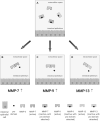Metalloproteinases in Inflammatory Bowel Diseases
- PMID: 33790618
- PMCID: PMC8001665
- DOI: 10.2147/JIR.S288280
Metalloproteinases in Inflammatory Bowel Diseases
Abstract
Inflammatory bowel diseases (IBD) are chronic inflammatory diseases of the gastrointestinal tract, encompassing two main disorders: Crohn's disease (CD) and ulcerative colitis (UC). In both these pathologies, excessive and local immune response against luminal antigens promotes a pathological process leading to various degrees of gut damage. Matrix metalloproteinases (MMPs) are a family of neutral proteases with the ability to degrade all components of extracellular matrix. In physiological conditions, MMPs are produced at very low level and generally in the latent form and are involved in the normal tissue turnover. Their function is inhibited by tissue inhibitors of metalloproteinases (TIMPs). However, in inflamed tissue of IBD patients, MMPs are produced in excess and/or the activity of TIMPs is not sufficient to block MMPs, thereby making a major contribution to the IBD-related mucosal degradation. In this review, we summarize the available evidence on the expression and role of MMPs in IBD.
Keywords: Crohn’s disease; intestinal inflammation; tissue inhibitor of metalloproteinases; ulcerative colitis.
© 2021 Marônek et al.
Conflict of interest statement
The authors declared no conflicts of interest in this work.
Figures


References
Publication types
LinkOut - more resources
Full Text Sources
Other Literature Sources

